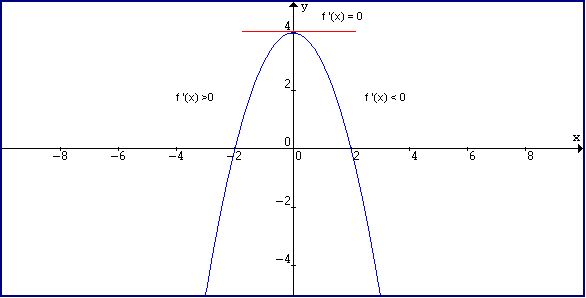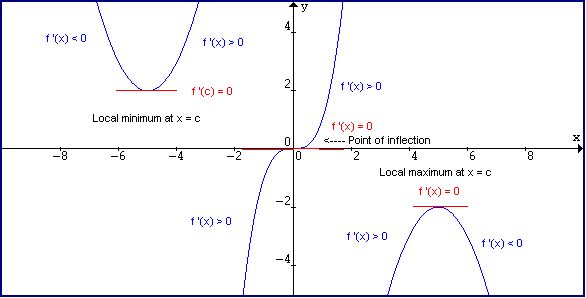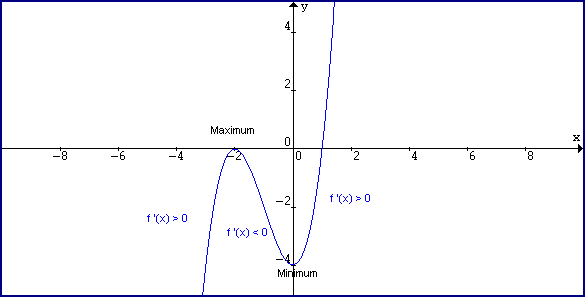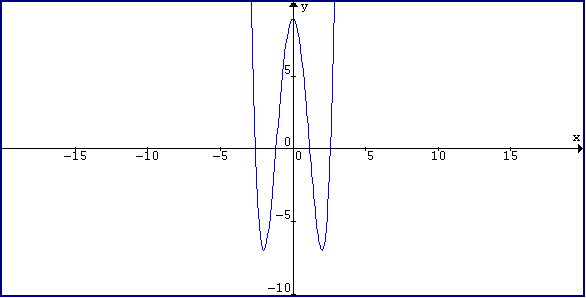
Derivatives in Curve Sketching
Derivatives can help graph many functions. The first derivative of a function is the slope of the tangent line for any point on the function! Therefore, it tells when the function is increasing, decreasing or where it has a horizontal tangent! Consider the following graph:

Notice on the left side, the function is increasing and the slope of the tangent line is positive. At the vertex point of the parabola, the tangent is a horizontal line, meaning f '(x) = 0 and on the right side the graph is decreasing and the slope of the tangent line is negative!
These observations lead to a generalization for any function f(x) that has a derivative on an interval I :
- 1) If f '(x) > 0 on an interval I, then the graph of f(x) rises as x increases.
- 2) If f '(x) < 0 on an interval I, then the graph of f(x) falls as x increases.
- 3) If f '(c) = 0, then the graph of f(x) has a horizontal tangent at x = c. The function may have a local maximum or minimum value, or a point of inflection.
Here are some graphs of each of the observations made above!

Some observations on the above graphs!
1) To be a minimum point, the graph must change direction from decreasing to increasing.
2) To be a maximum point, the graph must change direction from increasing to decreasing.
3) To be an inflection point, the graph doesn't change direction. In the above example ( one in middle) it is increasing before the f '(c) = 0 and it is still increasing after. You can also have one with the graph decreasing on both sides.
-
1) Find the critical points(maximum, minimum or inflection points) of the function
f(x) = x3 + 3x2 - 4. Then graph the function.
-
a) Find the critical points by finding f '(x).
-
Find
the zeros by solving f '(x) = 0
-
Therefore,
we have critical points at x = 0, and x = -2
Substitute these values into the original function to find the y values of the critical points. The points are (0, -4) and (-2, 0)
| f '(x) | |
| x < -2 | + |
| x = -2 | 0 |
| -2 < x < 0 | - |
| x = 0 | 0 |
| x > 0 | + |
The chart shows that (-2, 0) is a local Max. and (0, -4) is a local min. You can tell because of the sign changes!
c) Find the zeros of the original function. These are the x-intercepts. You can use synthetic division and factoring to find the zeros! They are (-2, 0) (double root) and (1, 0)
d) Find the y-intercept. This is the constant of the original function. (0, -4)
e) Now take the limit as x goes to both infinities of the original function. ![]()
![]()
f) Now put all these together and graph the function!

-
a) Find the critical points by finding f '(x)
-
Set f '(x) = 0 and solve
4x(x2 - 4) = 0
4x(x - 2)(x + 2) = 0
-
Therefore, the critical points are at x = 0, x = 2 and x = -2
Substitute these into the original function and the points are (0, 9), (2, -7), (-2, -7)
f '(x) |
|
x < -2 |
- |
x = -2 |
0 |
-2 < x < 0 |
+ |
x = 0 |
0 |
0 < x < 2 |
- |
x = 2 |
0 |
x > 2 |
-
The chart shows that (-2, -7) and (2, 7) are minimums and (0, 9) is a maximum. Check out the signs on the chart to realize this!
d) The y intercept is (0, 9) e) Find the limits on infinity. ![]()
![]()
f) Put these together and graph the function!

Quiz
f(x) = x3 + 3x2 - 4
|
1) What are the x-intercepts of f(x)? |
 |
|
(1, 0) |
|
|
(-2, 0) |
|
|
(0, 0) |
|
|
(1, 0) and (-2, 0) |
|
|
doesn't cross x axis |
|
2) What are the critical points? |
 |
(-2, 0) and (0, 0) |
|
(-2, 0) and (0, -4) |
|
(1, 0) and (0, 0) |
|
(1, 0) and (0, -4) |
|
Just (0, 0) |
|
3) Which point is a local maximum? |
 |
(-2, 0) |
|
(0, 0) |
|
(1, 0) |
|
(0, -4) |
|
doesn't have one |
|
3) What point is a local minimum? |
 |
(-2, 0) |
|
(0, 0) |
|
(1, 0) |
|
(0, -4) |
|
doesn't have one |
|
3) What point is an inflection point(critical)? |
 |
(-2, 0) |
|
(0, 0) |
|
(1, 0) |
|
(0, -4) |
|
doesn't have one |
|